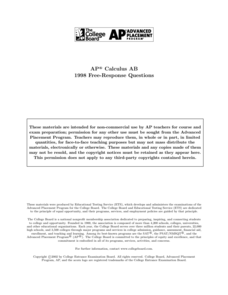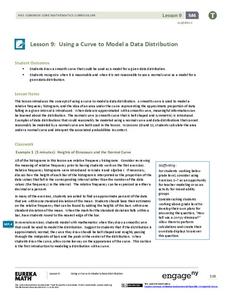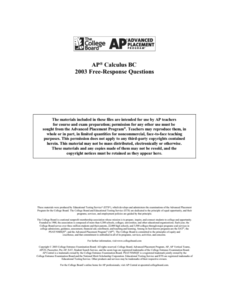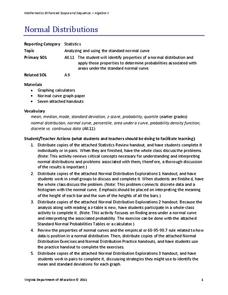Flipped Math
Calculus AB/BC - Applying Properties of Definite Integral
Properly apply the properties of integrals. By watching a video, scholars learn about the properties of definite integrals. They see how to use the area under a curve and the properties to determine the value of a given definite integral.
College Board
1998 AP® Calculus AB Free-Response Questions
Take a peek into the exam. Released items from the Calculus AB exam provide pupils insight into how questions appear on the exam. The six questions range from finding the area under a curve and the volume of the revolution to working...
Radford University
Are Kitchen Cabinets at the Correct Height? Lessons 1-5
Here's a not-so-normal unit on normal heights. Future statisticians anonymously collect class data on female heights, weights, and shoe sizes. They then analyze the data using normal distributions, z-scores, percentiles, and the...
Flipped Math
Calculus AB/BC Mid-Unit 6 Review: Integration and Accumulation of Change
Accumulate the content so far. Learners review the content from the first five lessons dealing with accumulation functions. The eight problems go over finding maximums, minimums, concavity, points of inflection, and intervals of increase...
CK-12 Foundation
Properties of a Normal Distribution: Uniform Distributions
There's nothing normal about an extraordinary resource. Scholars change the dimensions of a normal distribution using a slider interactive. Determining the area under the graph gives probabilities for different situations.
Radford University
What Is Normal?
Are you taller than a Major League Baseball player? Future mathematicians learn about normal distributions, percentiles, z-scores, and areas under a normal curve. They use the concepts to analyze height data of Major League Baseball...
Curated OER
Area Under A Curve
Students investigate the concept of finding the areas under curves while examining the graphing for inscribed and circumscribed rectangles. Finally, students compute the area under the curve by using the left-hand endpoints. The examples...
Shodor Education Foundation
Overlapping Gaussians
Adjust the overlap to compare probabilities. Using sliders, learners adjust the shape of two Gaussian curves. The interactive calculates the area of the left tail for one curve and the right tail for the other. Pupils set the interactive...
Curated OER
Roller Coaster Robot
Students calculate the area under a curve. In this calculus lesson, students use Riemann sums to find and approximate the area under a curve. They use the derivative and differential equations to solve.
Curated OER
Lesson #94 Exact Area Under A Curve
Students examine diagrams to determine the exact area under a curve. Using given formulas, they identify the area of the curve using the x and y-axis, as well as rectangles. As a class, students sing a song called "Failing My Calculus"...
Flipped Math
Calculus AB/BC - Interpreting the Behavior of Accumulation Functions Involving Area
Accumulation functions should behave like other functions. Using content from Unit 5, pupils analyze the first and second derivative to determine the behavior of an accumulation function. Learners find out how to calculate the relative...
College Board
2007 AP® Calculus BC Free-Response Questions
Provide a review for the exam so individuals don't tank. AP® provides the free-response questions for teachers to use to help their pupils prepare for the exam. The six BC questions from 2007 include regions bounded by functions, water...
College Board
2009 AP® Calculus AB Free-Response Questions
What was one of the big takeaways from 2009? By reviewing the released AP® Calculus free-response questions, pupils and teachers realize that performing mathematics is not all there is to doing well on the exam. Several items require...
EngageNY
Using a Curve to Model a Data Distribution
Show scholars the importance of recognizing a normal curve within a set of data. Learners analyze normal curves and calculate mean and standard deviation.
Balanced Assessment
On Averages and Curves
Determine the average on a curve. The class finds graphical representations of averages and expresses them both symbolically and on the graph. The assessment requires class members to justify using average to describe graphs.
College Board
2011 AP® Calculus BC Free-Response Questions Form B
Take a second look. Form B of the AP® Calculus BC free-response questions allow pupils and teachers to see another set of items. The six questions expand the set of items from the 2011 free-response questions. Form B items include a...
College Board
2006 AP® Calculus BC Free-Response Questions
Move along with the review. Teachers and scholars use the six released free-response questions to review for their upcoming AP® exam. Questions from the 2006 exam contain problems dealing with cars, objects moving along a curve, and...
College Board
2005 AP® Calculus AB Free-Response Questions Form B
Grab a peak inside the test. The 2005 free-response questions from the AP® Calculus exam allow learners to see how topics appear on the tests. Topics cover differential equations, bounded areas, particle motion, and slopes of tangent lines.
College Board
2003 AP® Calculus BC Free-Response Questions
There are shaded areas, particles, polar equations, oh my! Teachers use the materials to see how their pupils compare to the AP® Calculus BC exam expectations. Scholars use the released items to practice on several BC topics and become...
Curated OER
Little Red Corvette
Learners investigate the acceleration of a car. In this acceleration of a car instructional activity, students make a scatter plot of corvette acceleration data. Learners find a model to fit the data by taking the integral of...
Virginia Department of Education
Normal Distributions
Pupils work to find probabilities by using areas under the normal curve. Groups work to calculate z-scores and solve real-world problems using the empirical rule or tables.
EngageNY
Normal Distributions (part 2)
From z-scores to probability. Learners put together the concepts from the previous lessons to determine the probability of a given range of outcomes. They make predictions and interpret them in the context of the problem.
Curated OER
A.P. Calculus Integration Test
In this A.P. Calculus activity, students complete a sixteen question test covering trigonometric integration, area under a curve, differential equations, and slope fields. Some of the problems are multiple choice, while others are...
Curated OER
Errors in Riemann Sums
In this Riemann Sums worksheet, students use the Riemann Sums method to approximate the area under the curves. This two-page worksheet contains three problems.























